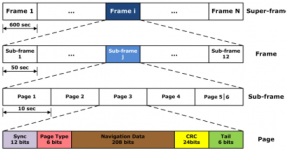The page is the basic structure for building the navigation message. They can be found the following fields within a page:
Sync: The synchronization pattern (101101110000), which is not encoded, allows the receiver to achieve synchronisation to the page boundary
Page type: 6 bits to identify the page content
Navigation data: 208 bits
CRC: 24 bits to detect potential bit errors. Computed on the page type and navigation data fields
Tail: consists of 6 zero-bits enabling completion of the FEC decoding of each page’s information content in the user receiver
There are 6 page types, which content is shown next:
Type 1: SVID, clock correction, SISA, Ionospheric correction, BGD, Signal health status, GST and Data validity status
Type 2: Ephemeris (1/3) and GST
Type 3: Ephemeris (2/3) and GST
Type 4: Ephemeris (3/3), GST-UTC conversion, GST-GPS Conversion and TOW
Type 5: Almanac for satellite k and almanac for satellite (k+1) part 1
Type 6: Almanac for satellite (k+1) part 2 and almanac for satellite (k+2)
Note: the parameter k is transparent for the user. It is set by the Galileo system for each of the active satellitesEach Subframe is composed by 5 pages. The first four pages in a subframe are always of type 1 to 4, while the fifth one varies. Odd numbered subframes contain the page type 5 and the even numbered subframes contain the page type 6.
In case no valid F/NAV data is to be transmitted, the satellite generates and downlinks the dummy pages (Type 63) replacing the pages in the nominal sequencing,


1. What is ‘k’ ? Is it SVID ?
2. There are 12 subframes. and if k=0, we can have access to 17 satellites and if k=1, we have 18 satellites. Is this true?
3. How ephemeris is related to ‘k’ ?